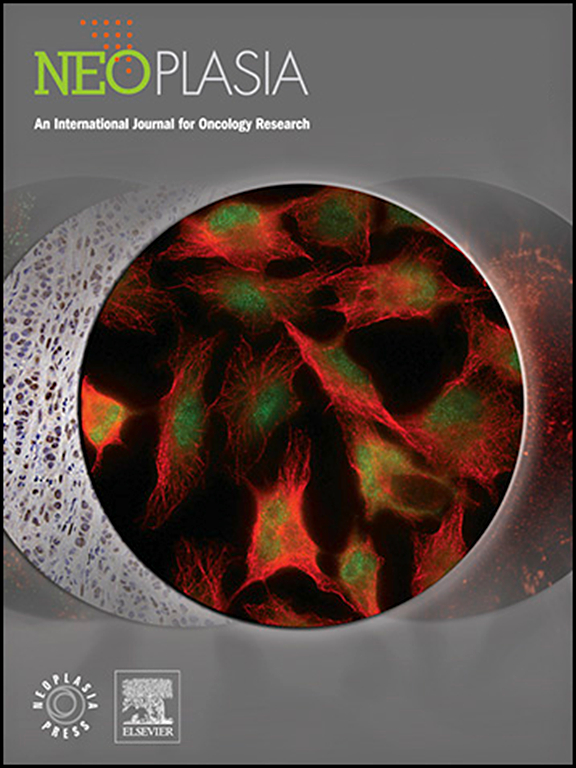抑制 RRM2 可通过 ATM/Rb/E2F1 通路改变非典型畸胎性横纹肌瘤的细胞周期。
IF 4.8
2区 医学
Q1 Biochemistry, Genetics and Molecular Biology
引用次数: 0
摘要
背景:非典型畸形横纹肌瘤(ATRT)是一种侵袭性脑肿瘤,主要影响幼儿。我们最近的研究报告了一种很有前景的治疗策略,即通过靶向核糖核苷酸还原酶调节亚基 M2(RRM2)引发 DNA 损伤、阻碍同源重组修复并诱导 ATRT 细胞凋亡。RRM2抑制剂COH29能有效降低肿瘤生长并延长体内存活时间。在此,我们探讨了控制这些功能的潜在机制,以提高 COH29 在 ATRT 中的临床适用性:方法:分析 ATRT 患者和 COH29 处理细胞的分子谱,以确定特定的信号通路,然后使用基因敲除系统、流式细胞术、q-PCR 和 Western 印迹进行验证:结果:E2F1及其信号通路的升高与预后不良相关。抑制RRM2可诱导DNA损伤并激活ATM,从而减少Rb磷酸化,促进Rb-E2F1相互作用,阻碍E2F1功能的发挥。E2F1活性抑制导致E2F1依赖性靶点表达减少,导致细胞周期停滞在G1期,S期细胞减少,DNA损伤修复受阻:我们的研究强调了ATM/Rb/E2F1通路在RRM2抑制诱导的DNA损伤中控制细胞周期停滞和细胞凋亡的作用。结论:我们的研究强调了ATM/Rb/E2F1通路在RRM2抑制诱导的DNA损伤中控制细胞周期停滞和细胞凋亡的作用,这为COH29的治疗效果提供了启示,并建议将该通路作为治疗ATRT的潜在靶点。本文章由计算机程序翻译,如有差异,请以英文原文为准。
RRM2 inhibition alters cell cycle through ATM/Rb/E2F1 pathway in atypical teratoid rhabdoid tumor
Background
Atypical teratoid rhabdoid tumor (ATRT) is an aggressive brain tumor that mainly affects young children. Our recent study reported a promising therapeutic strategy to trigger DNA damage, impede homologous recombination repair, and induce apoptosis in ATRT cells by targeting ribonucleotide reductase regulatory subunit M2 (RRM2). COH29, an inhibitor of RRM2, effectively reduced tumor growth and prolonged survival in vivo. Herein, we explored the underlying mechanisms controlling these functions to improve the clinical applicability of COH29 in ATRT.
Methods
Molecular profiling of ATRT patients and COH29-treated cells was analyzed to identify the specific signaling pathways, followed by validation using a knockdown system, flow cytometry, q-PCR, and western blot.
Results
Elevated E2F1 and its signaling pathway were correlated with poor prognosis. RRM2 inhibition induced DNA damage and activated ATM, which reduced Rb phosphorylation to promote Rb-E2F1 interaction and hindered E2F1 functions. E2F1 activity suppression led to decreased E2F1-dependent target expressions, causing cell cycle arrest in the G1 phase, decreased S phase cells, and blocked DNA damage repair.
Conclusion
Our study highlights the role of ATM/Rb/E2F1 pathway in controlling cell cycle arrest and apoptosis in response to RRM2 inhibition-induced DNA damage. This provides insight into the therapeutic benefits of COH29 and suggests targeting this pathway as a potential treatment for ATRT.
求助全文
通过发布文献求助,成功后即可免费获取论文全文。
去求助
来源期刊

Neoplasia
医学-肿瘤学
CiteScore
9.20
自引率
2.10%
发文量
82
审稿时长
26 days
期刊介绍:
Neoplasia publishes the results of novel investigations in all areas of oncology research. The title Neoplasia was chosen to convey the journal’s breadth, which encompasses the traditional disciplines of cancer research as well as emerging fields and interdisciplinary investigations. Neoplasia is interested in studies describing new molecular and genetic findings relating to the neoplastic phenotype and in laboratory and clinical studies demonstrating creative applications of advances in the basic sciences to risk assessment, prognostic indications, detection, diagnosis, and treatment. In addition to regular Research Reports, Neoplasia also publishes Reviews and Meeting Reports. Neoplasia is committed to ensuring a thorough, fair, and rapid review and publication schedule to further its mission of serving both the scientific and clinical communities by disseminating important data and ideas in cancer research.
 求助内容:
求助内容: 应助结果提醒方式:
应助结果提醒方式:


